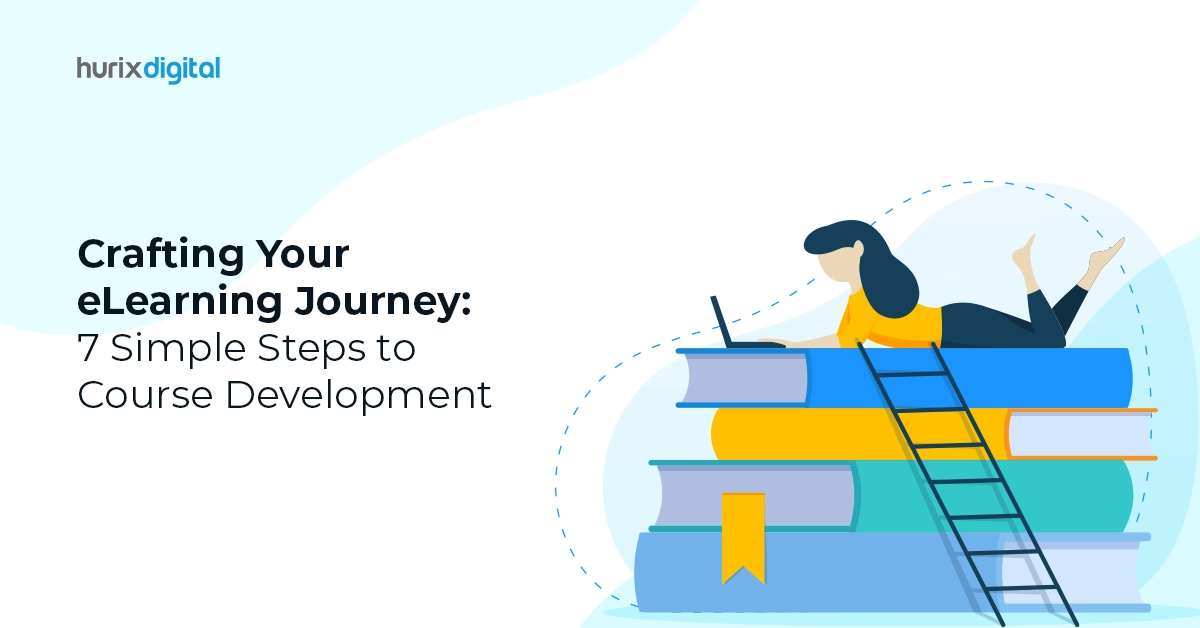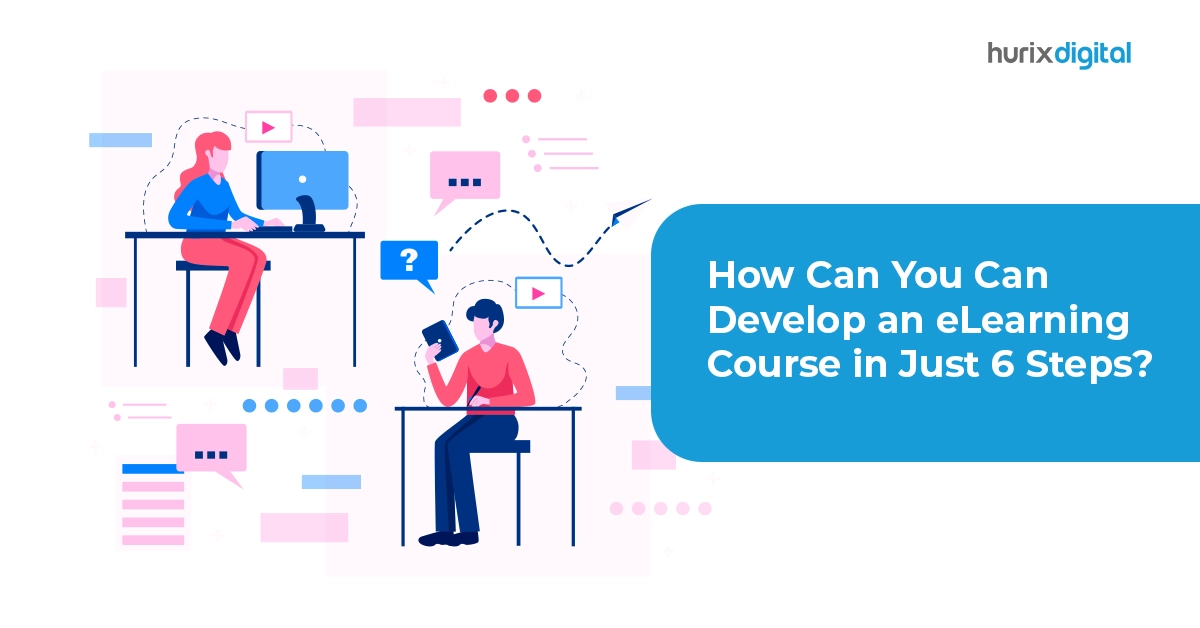
Crafting Your eLearning Journey: 7 Simple Steps to Course Development
If you are looking for an eLearning Course Development plan for higher education learning or corporate training, you have reached the perfect place!
It could be a tedious job to plan, outline, design, launch, and market an effective eLearning course development structure. Organizations must create an engaging eLearning curriculum design and initiate a powerful Instructional Design Process that can deliver knowledge and engage learners.
It could be a difficult process to transition from scratch to full-fledged eLearning course planning. Welcome to this step-by-step guide, which is approved by professionals and subject-matter experts to help you create an exceptional course structure. This process also includes instructional design best practices that will equip you with the appropriate skills and knowledge to create an outstanding course for modern learners.
Table of Contents:
Significance of eLearning Course Development
It is important to understand why eLearning Course Development is so important today. The world is driven by digital learning and reading because it is a cost-effective alternative.
Besides, it is also a sustainable and eco-friendly option that offers personalized convenience that allows students to learn at their own pace.
Let us look at some facts here:
- Online learning has grown by 900% since 2000 and the number of online learners is expected to reach 57 million by 2027. It has also been researched that digital learning can enhance student retention by 50% and reduce the time taken to comprehend a subject by 40%–60%
- The global eLearning market reached $316.2 billion in 2023 and is expected to reach $661.6 billion by 2032.
Here are some of the main reasons why eLearning course planning and development are fundamental in today’s technology-driven learning arena:
- Students don’t need to follow a stringent schedule that is applied to a physical classroom, and they can access course materials whenever it suits them.
- Modern learners have busy lifestyles and varying time zones; thus, such courses help them gain knowledge from the comfort of their homes and remove geographical barriers.
- One of the biggest advantages is that learners enjoy individualized guidance from instructors. Moreover, they can connect with like-minded individuals from around the world.
- It becomes easier for students to deal with real-world problems.
- Such courses enhance long-term growth, learning, and development, which helps them build sound networks and propagate their professional lives.
- Taking online courses, helps students develop time management skills, and enrich their learning journey.
- Finally, digital courses help students save money, especially costs related to commuting, traveling overseas, accommodations, investing in paperback course materials, etc.
Also Read: The Future of Social Media In eLearning: Predictions and Emerging Trends
7 Steps of eLearning Course Development
Creating an eLearning course means following 7 essential steps to help educators and organizations deliver high-quality content. Let us go through the process:
Step 1: Initial Planning and Market Research
The first step is to conduct thorough market research and identify the purpose of the digital course. Here are some course development strategies that you can follow:
- Consider your organizational or student-learning needs and identify market and industry trends
- Investigate market employment postings, social media discussions, and industry reports to ensure there is a demand for the course you are planning to launch.
- Define clear and specific training goals according to your target audience’s needs.
- Consider your Perfect Learner Profile (PLP) and the Learning Transformation Statement (LTS) to ensure that your content development for eLearning is intelligent and transformative.
Step 2: Course Topic Selection and Collecting Source Material
Once you have identified your digital training needs and objectives, you must gather source material and choose a topic that matches the expertise and interests of students. Ensure there is high market demand for your chosen topic.
Here are some best practices:
- Conduct market research, surveys, online community discussions, and industry reports.
- Select a relevant topic that addresses a particular skill or knowledge gap.
- Verify the credibility of your topic and ensure it meets the course objectives.
- Remain open to new information and updates in your field
- Rely only on high-quality source material if you want to create a successful eLearning Course.
Step 3: Crafting a Clear and Concise Outline
Now, it’s time to transform your gathered source material into a brief outline. In this stage of eLearning Course Development, the frame for an outline that spans from start to finish is listed in bullet points, with each milestone expanded into subtopics.
Focus on the main headings and ensure that the material you intend to deliver fits into your designed outline. Here are some tips to consider before you create the outline during eLearning course planning:
- Your outline must contain the ultimate objective and outcome—what learners will achieve in each module.
- The foundation of building an online business should be SMART objectives: Specific, Measurable, Achievable, Relevant, and Time-bound.
- A well-designed and professionally formulated outline motivates learners to initiate their learning journey.
- Outline the main topics of the course and offer a high-level preview and overview to your modern learning audience.
Step 4: Crafting a Script and Designing Engaging Content
This is the stage where you add depth to your eLearning course development. Content development for eLearning includes eLearning curriculum design, which transforms your outline into full-fledged lessons.
Here are some instructional design best practices that educators and organizations must follow:
- Allow the content to flow visually.
- Create a storyboard and include the sequence of course inclusions, chapters, text, visuals, presentations, audio, and infographics.
- Frame a structured and organized course layout by using presentations, FAQs, assessments, demos, or tutorials, and consider activities that encourage student engagement.
- Include interactive activities and engagement techniques that can elevate the interest and retention of learners. Introduce quizzes, gamification, 3D graphics, GIPs, and animations to simplify complex topics and help students create relatable stories.
- Break down each section into clear and concise segments, and make sure that the language is concise, effective, engaging, and easy to understand.
- You must also ensure that the content structures are accessible to all, irrespective of physical or geographical constraints.
- It is highly recommended to rely on professional online services to help you with content development for eLearning.
Step 5: Production and Delivery
The quality of course formulation, production, and delivery significantly impacts learner engagement. If you are creating the course on your own, you must pay impeccable attention to detail, ensuring a polished and professional final product.
However, if you are relying on expert and professional services, you can sit back, monitor, and guide them on the best eLearning course planning.
Here are some key factors to consider when delivering the final product:
- Follow a robust course creation and Instructional Design Process. The editing process should further refine and enhance the content and the course.
- Evaluate the user interface and compatibility of your course with various devices according to diverse learner needs.
- Choose the best eLearning Course Development platform that fulfills your technical requirements and ensures a conducive learning environment.
- Make sure you collaborate with the best course development online platform that integrates with your existing LMS, offers content protection, and maximizes effectiveness.
- Select the delivery and distribution methods for your online course.
Step 6: Pricing and Marketing
Establish a solid pricing structure and assess the value your course offers. Consider factors like the depth of content, additional resources provided, or personalized support offered.
You can start by offering introductory pricing to cater to different learners’ needs. Then smartly balance affordability and value and focus on how learners see the worth of their investment. It is essential to promote your course to generate excitement among learners.
Here are some ways in which you can market your course:
- Identify the channels frequented by your target audience
- Use modern marketing avenues like social media, email campaigns, or partnerships with industry influencers.
- Use interactive advertisements or messaging to convey the unique value of your course.
- Consider offering discounts or exclusive access and post-learner reviews and feedback to build anticipation. Engage and network with other educational organizations or communities to promote active student participation and collaboration.
- Implement mechanisms for continuous feedback to assess course effectiveness.
Step 7: Testing and Upgrading
This step is crucial, specifically after its launch, to assess whether your eLearning course meets the required standards and is effective for learners. Conduct Quality Assurance (QA), Accessibility Testing, and User Acceptance Testing UAT to check its functionality, user experience, and compatibility with other technologies.
Test your course on various web browsers and devices, and review all course content for accuracy and relevance. Use feedback from testing phases to make necessary upgrades and improvements to your course content. Rely on data analytics to eradicate pain points and enhance the overall learning experience.
Ensure an ongoing process of course monitoring and upgrading regularly to keep your course relevant.
Also Read: A Complete Guide on eLearning Localization to Enhance Your Global Training Programs
Conclusion
It is paramount to recognize the right procedure for eLearning Course Development and the lasting impact of a well-designed course. It fulfills educational objectives, empowers learners with valuable skills, knowledge, and confidence, and further nurtures their passion for lifelong learning.
It is important to rely on core professional online resources like Hurix Digital for effective and outstanding eLearning Course Development. Professionals with abundant expertise and experience will guide you with expert guidance, help you understand the entire process, and transform your course creation journey.
To learn more about Hurix Digital, schedule a demo with us today!

Performance, Results, Growth, and Life-Long Learning define my professional life. I am passionate about making workplace learning planful, purposeful, and impactful. I take pride in partnering with clients and bringing them the best in learning design and creating solutions that address business challenges.









